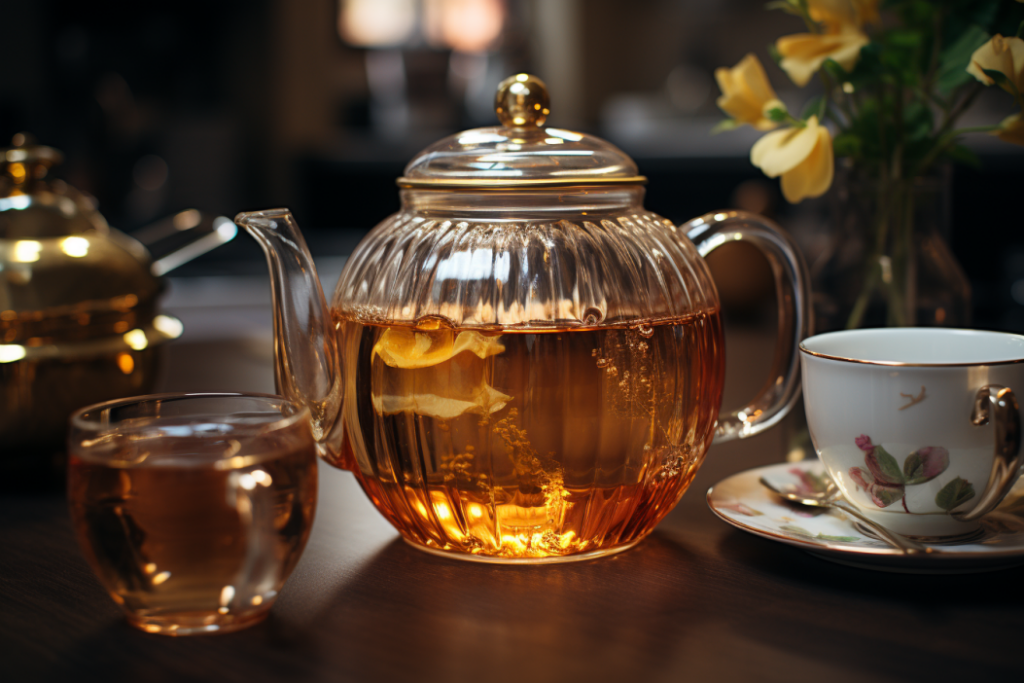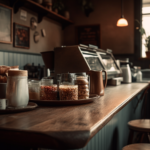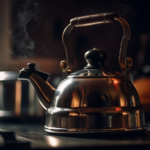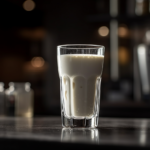Table of Contents
Step-by-Step Process to Brewing Your Own Herbal Tea Comfortably at Home
Hello, fellow tea enthusiasts! Have you ever wanted to dive into the world of homemade herbal tea, when only the supermarket’s tea selection isn’t cutting it anymore? Well, you’re in the right spot! I’m stoked to share with you my ultimate guide to making herbal tea right at home. Before you know it, you’ll be sipping on a cup of your own handcrafted brew, filled with flavours that you’ve purposely tossed together.
We aren’t talking about sticking a tea bag into a cup of hot water! Nope, we’re discussing how to blend your own herbs, flowers, spices, and more. Trust me; this little adventure is a game-changer, nothing can beat the taste and satisfaction you get from consuming your homemade herbal tea. So, if you’re ready to roll up your sleeves and introduce yourself into this fulfilling and therapeutic DIY tea making journey, keep on reading! Isn’t it the perfect time to add a tidbit of tea magic to your day? Let’s get brewing, folks!
Getting Started: Tools and Ingredients for your Home-Brewed Herbal Tea
Getting Started: Tools You’ll Need
- The Perfect Teapot
Kickstarting your herbal tea adventure means getting your hands on the right teapot. This is where your tea will come to life, it’s essential to choose one that resonates with your vibe.
- Tea Infuser or Strainer
Unless you plan on chewing those tea leaves – and no judgment if you do – you’re going to need a good-quality tea infuser or strainer.
- Measuring tools
Making the perfect cup of herbal tea isn’t just a throw-this-in, throw-that-in scenario. Accuracy matters here, so get your teaspoons, tablespoons, and cups ready!
Essential Ingredients for Your Home-Brewed Herbal Tea
- Herbs
The heart of your tea, herbs, can be sourced fresh from your garden or dried from local farmers markets or health food stores. Experiment with different herbs like peppermint, chamomile, or lemongrass – the options are endless!
- Water
This might seem like a given, but the type and temperature of water you use significantly impacts your tea’s taste. Filtered water and spring water are hailed as the top choices for brewing.
- Natural Sweeteners
If you’re someone with a sweet tooth, natural sweeteners are a great addition. Honey, agave syrup, or stevia are good options to customize your tea.
- Spices and Citrus
Adding spices and citrus can provide your tea with a kick and depth of flavor. Staples like ginger, cinnamon, lemon or orange zest should definitely be in your herbal tea toolkit.
Remember folks, the beauty of making your own herbal tea lies in the freedom to whip up a concoction that’s uniquely yours. So, don’t be shy experiment! Happy brewing!
Understanding Different Types of Herbs and Their Benefits
Demystifying Herbs: Different Types and Their Benefits
Not all herbs are created equal. Each has its own unique flavor profile and health perks. Let’s delve into some popular tea-friendly herbs.
- Peppermint
- Chamomile
This gentle little flower is the sleeping beauty of herbs. A cup of chamomile tea before bed can help usher in a peaceful night’s sleep. Plus, it can help with digestion, much like its peppermint friend.
- Lemongrass
This citrusy herb has a boatload of benefits. It not only assists in digestion but is also said to relieve anxiety and lower cholesterol. Added bonus? One whiff of this fresh, lemony scent, and you’ll be in love!
- Lavender
Lavender isn’t just a pretty plant. This fragrant herb is a relaxation powerhouse, known for its calming properties. Looking for a way to wind down after a long day? A cup of lavender tea might just be the ticket.
- Ginger
Spicy, warm ginger is your go-to herb for its healing qualities. It’s fantastic for fighting off colds and soothing sore throats. Ginger tea? Yes, please!
This aromatic herb isn’t just fantastic for its refreshing taste, it’s also got some nifty health benefits. Peppermint is known to aid digestion and help with nausea. Planning a big meal? Brew yourself a post-dinner minty infusion!
Remember, the world of herbs is wide and wonderful. This is just a little taste of the adventure that awaits! As you embark on your homemade herbal tea journey, explore, and experiment. Who knows what delightful concoctions you might brew up? Cheers to discovering your new favorite wellness potion, tea lovers!
The Art of Blending: Mixing Herbs for a Unique Tea Experience
Welcome to the fun part, tea lovers! It’s time to unlock your inner mixologist and understand the art of blending herbs. Let’s get to it!
- Choosing Your Base
The base of your tea blend is what gives it body and enhances the overall flavor. It’s usually a mellow-tasting herb like, well hello again, chamomile or peppermint. The base typically makes up about 50-70% of your blend.
- Adding Complementary Herbs
Once you have your base, you can start adding complementary herbs (preferably, rich in flavor like ginger or lemon balm) that make up about 20-30% of your mix.
- The Aesthetics and Enhancers
Lastly, we add herbs and spices that will pop in color, smell, or taste! These are your aesthetic elements and enhancers such as lavender or cinnamon which is around 10-20% of the blend. Remember, these pieces, while smaller in quantity, pack a punch!
- Sampling and Adjusting Your Blend
This is where you take a sip and become your very own critic. Does your blend need a touch more peppermint or perhaps a dash of extra cinnamon? Adjust as you see fit and perfect your signature sip.
- Storing Your Blend
Once you’ve created your masterpiece, store it in a cool, dark place away from strong odors. A glass jar is perfect for keeping your homemade blend fresh and ready for your next pot of tea.
Remember, blending is a creative process, folks. Feel free to experiment and make tweaks until you find your perfect cup. After all, this is your unique tea experience, and there’s no right or wrong here. Happy blending, and here’s to many flavorful brews ahead!
Step-By-Step: A Detailed Guide to Brewing Your Herbal Tea at Home
Alright, folks! It’s time to put those newfound herbal insights to use and get brewing. Here’s a simple step-by-step guide to help you brew the perfect cup of homemade herbal tea.
- Calculate Your Quantities
The golden rule of tea-making? For each cup of tea, use a cup of water and a teaspoon of your tea blend. Got it? Let’s get to the good stuff!
- Boil Your Water
Remember our water chat, yeah? Use filtered or spring water if possible and bring it to a boil. If you’re using fresh leaves, aim for slightly cooler water to keep the leaf structure intact.
- Steep Your Tea
Put your tea mix into an infuser or strainer, place it in your cup, and pour hot water over it. Let it steep. Most teas do well with a 5-7 minute bask in hot water. Feel like stronger flavor? Leave it in a tad longer!
- Remove and Squeeze
Once your tea has reached the strength you like, remove the infuser or strainer and give it a little squeeze to release any trapped flavorful goodness.
- Add a Natural Sweetener (Optional)
If you’ve got a sweet tooth, now’s the time to add a bit of honey or any other natural sweetener. Give it a good stir, and voila!
- Enjoy Your Tea
And now, the moment you’ve worked for. Sit back, take a deep breath, and savor your freshly brewed, homemade herbal tea. Cheers to you, tea-maker!
Remember, the beauty of making herbal tea at home is in the journey as much as the destination. So let’s not rush too much, enjoy the process, every scoop of tea, and every sip. Congratulations on becoming a home brewer, and here’s to many more cups enjoyed just the way you like them!
Maintaining Freshness: Tips for Storing your Homemade Herbal Tea
Great job on your blending and brewing, tea masters! But wait, there’s just one final hurdle – storing those homemade herbal treasures. Here’s how to keep your blends fresh and flavorful for longer.
- Choose the Right Container
Glass jars with airtight lids are your best bet. They’re not only non-reactive (so they won’t mess with your tea’s flavor), but also give you the joy of seeing your pretty blends when you open your pantry!
- Avoid Heat and Light
Herbs are a bit like vampires – they don’t like sunlight or heat. Store them in a cool, dark place to maintain their freshness and potency.
- Keep Away from Moisture
Moisture is to tea what kryptonite is to Superman. It’s a big no-no because it can lead to mold. So, store your tea in a dry place, and always use dry hands or utensils when handling it.
- Watch Out for Strong Odors
Herbs can pick up strong odors, which can mess up your tea’s taste. Make sure your storage spot is a good distance from strong-smelling foods.
- Use Within 6-12 Months
Even with the best storage, herbs don’t last forever. Try to use your homemade herbal tea within 6-12 months. They might just be your motivation to keep blending and brewing new batches!
So there you have it, folks. You’re now a fully-fledged home herbal tea guru! From understanding different herbs to perfecting your brew and storing your tea like a pro, you’ve mastered it all. Here’s to a lifetime of delightful, homemade tea adventures. Keep brewing, keep experimenting, and most importantly, keep enjoying those fantastic herbal infusions. Cheers to you, tea-lovers!
Mix it Up: Trying Out Different Herbal Tea Recipes
Now that you’ve mastered the basics, it’s time to unleash your inner tea artist and experiment with different home-brewed herbal tea recipes. Ready? Brew on!
- Calm Chamomile & Mint Medley
A soothing mix of calming chamomile and refreshing mint makes for a relaxing brew perfect to unwind at the end of the day. With about 70% of chamomile and 30% peppermint, this concoction is sure to become your go-to nightcap.
- Spice it Up: Ginger Cinnamon Delight
If you fancy a tea with a bit of heat and spice, try blending fresh ginger root and warming cinnamon. The robustness of ginger (40%) combined with earthy sweetness of cinnamon (60%) will give you a brew that warms you from the inside out.
- Citrus Surprise: Lemon Verbena and Rosemary
For a zesty wake-up call, try a blend of vibrant lemon verbena and aromatic rosemary. This blend offers a luscious blend of citrus and the Mediterranean flavor of rosemary (50% lemon verbena and 50% rosemary). Morning blues? What’s that?
- Sweet Dreams: Lavender Honey Tea
Create a dreamy bedtime tea with relaxing lavender and soothing honeybush. A 70% lavender and 30% honeybush mixture results in a naturally sweet brew that’ll have you ready for a peaceful slumber.
Remember that these recipes are just a jump-off point. Feel free to tinker with the ratios to suit your taste buds. The bliss of homemade herbal tea is that you’re the master of your brew. So, don’t shy away from playing around with different herbs, spices, and flavors.
Who knows, maybe your next experiment could result in your new favorite blend. So don’t stop experimenting, tea lovers! There’s a world of flavors out there waiting for you. Happy brewing!
Safety Tips: Things to Keep in Mind when Making Herbal Tea
Alright, tea enthusiasts, we’ve talked about the fun and flavor. Now, let’s have a quick chat about safety. Ready? Let’s spill the tea!
- Check for Allergies
Before you dive into any herbal tea blend, ensure you’re not allergic to any of the ingredients. A rash is not a great side-dish for a cup of tea!
- Be Aware of Medicinal Interactions
Some herbs can interact with medications. So, if you’re on any kind of drugs or treatment, do your research or, better still, consult your doctor before making your herbal brew.
- Pregnancy and Herbal Tea
Certain herbs are not recommended for pregnant or breastfeeding women. If you’re expecting or nursing, please check which herbs are safe for you and your little one.
- Quality Matters
Not all herbs are created equal, right? Always source your herbs from trustworthy suppliers or grow your own to ensure you get the best quality. No weird additives wanted in our cup, thank you!
- Proper Preparation and Storage
Herbal tea is super easy to prepare and store, but remember to follow the steps correctly to avoid spoilage. And always ensure your tools (jars, teaspoons, pots) are clean and dry.
- Less is More
While it can be tempting to add a lot of different herbs to your blend, start slow and stick to a handful of ingredients. It’s easier to identify something you don’t like in smaller, simpler blends.
So there we have it, friends! While brewing your own herbal tea at home is a healthy, creative, and rewarding endeavor, it’s crucial to be aware of safety measures. Put your health first and be mindful of these simple, yet essential safety tips. Here’s to many safe, healthy, happy brewing sessions. Cheers, tea lovers!
Beyond Brewing: Other Fun Ways to Use Your Herbal Tea
Hey there, tea aficionados! Let’s take our herbal tea love a little further and explore some fun, creative ways to use your homemade herbal tea, outside of your teacup. Intrigued? Let’s steep into it!
- Cook it Up
Herbal tea can be a fantastic, flavor-packed addition to your culinary creations. Use it as a base for soups, grains, or even to make a tasty marinade. Herbal tea, welcome to your cooking escapades!
- Tea Ice Cubes
Freeze your brewed tea into ice cube trays for some flavorful chill-ness, ideal for iced teas or summer cocktails. Plus, they look adorable! Hint: Use flower-shaped molds for an extra dose of cute.
- Herbal Bath Soak
After a long day, unwind with a relaxing herbal tea bath. Simply tie a handful of your favorite herbal mix in a muslin cloth and toss it in your bath. Ah, relaxation here we come!
- DIY Facial Steam
Brew your herbal tea and use it as a lovely, aromatic face steam. It’s like a mini spa session at home, detoxing your pores and leaving you refreshed. Remember to mind the temperature though, nobody wants a steam burn!
- Natural Dye
Some teas, like hibiscus or chamomile, can work as natural, eco-friendly dyes. So, have some old fabric or clothes that need a new look? It’s tea-dyeing time!
Remember, tea is not just a beverage, it’s an experience. And these unique uses of your homemade herbal tea can enhance this experience, providing joy, relaxation, culinary delight, and even a hint of beauty therapy.
So go on, brew masters, expand your horizons, and enter a world where the possibilities of what you can do with your herbal tea are endless. Let your creativity brew, along with your tea. Happy experimenting!
Conclusion
So there you have it, folks! Your go-to guide for all things related to homemade herbal tea. From understanding different herbs and their benefits, brewing like a pro, experimenting with fun blends, to storing and even getting adventurous with your tea beyond the mug. It’s been a joyful journey taking you through the beautiful, aromatic world of herbal tea. And now it’s your turn to grab your favorite mug, get cozy, and enter your very own tea haven at home.
Remember, the charm of homemade herbal tea lies in its uniqueness. Every sip represents your choices and creativity. Only you decide what goes into your blend, its distinctive flavors, and those magical enhancements that make every sip a delight.
Don’t be afraid to venture, experiment, and discover your own favorite mix. In the world of herbal tea, there are endless possibilities and plenty of room for fun and, of course, relaxation. So sit back, sip on, and celebrate your newfound love for homemade herbal tea. Here’s to many creative and calming brew sessions! Happy steeping, tea lovers!









